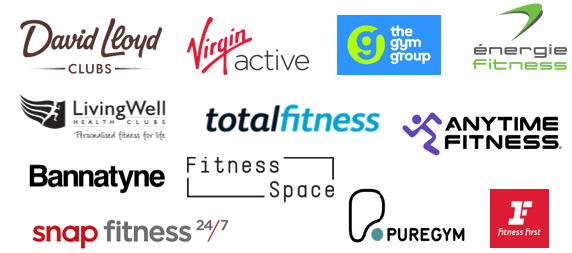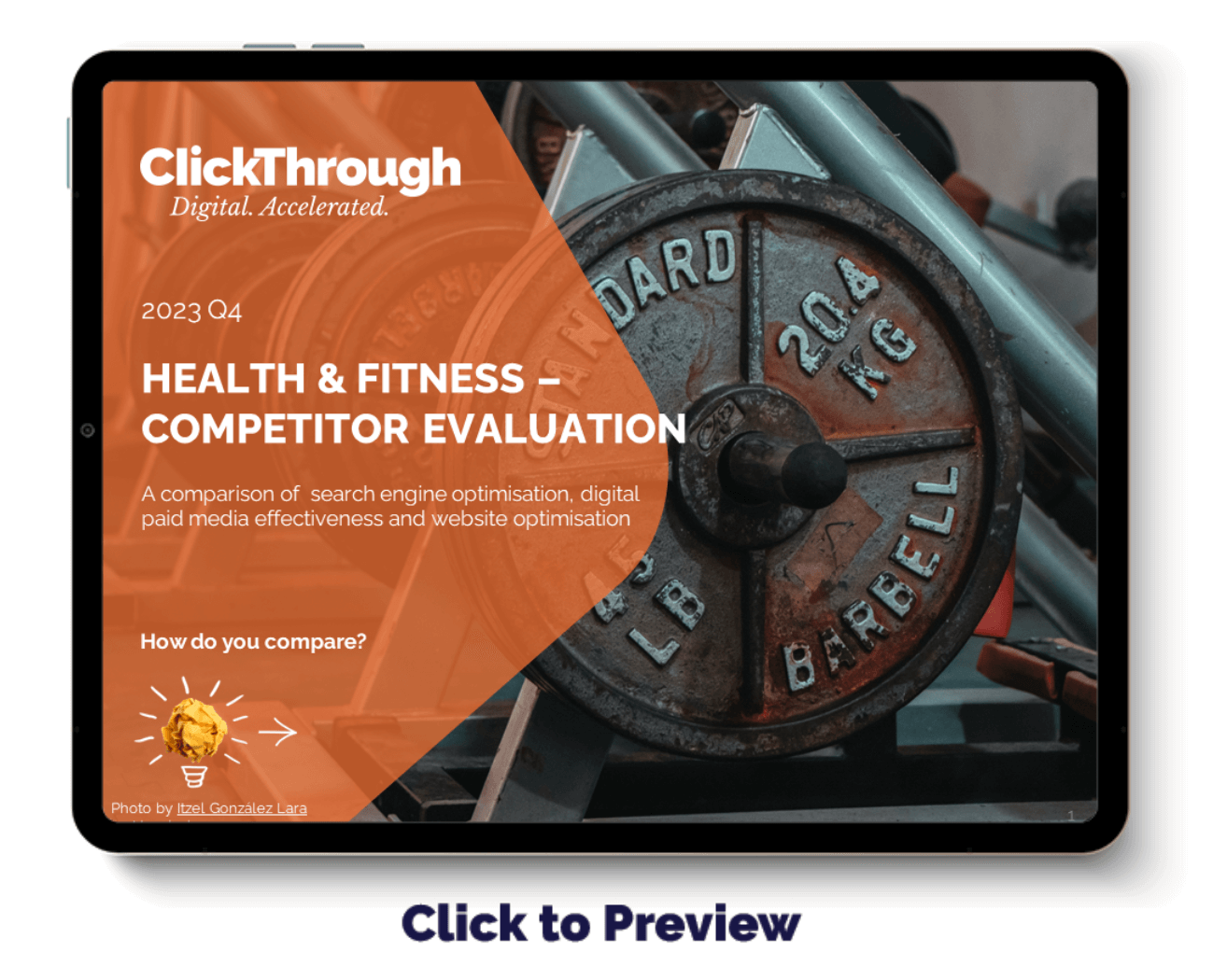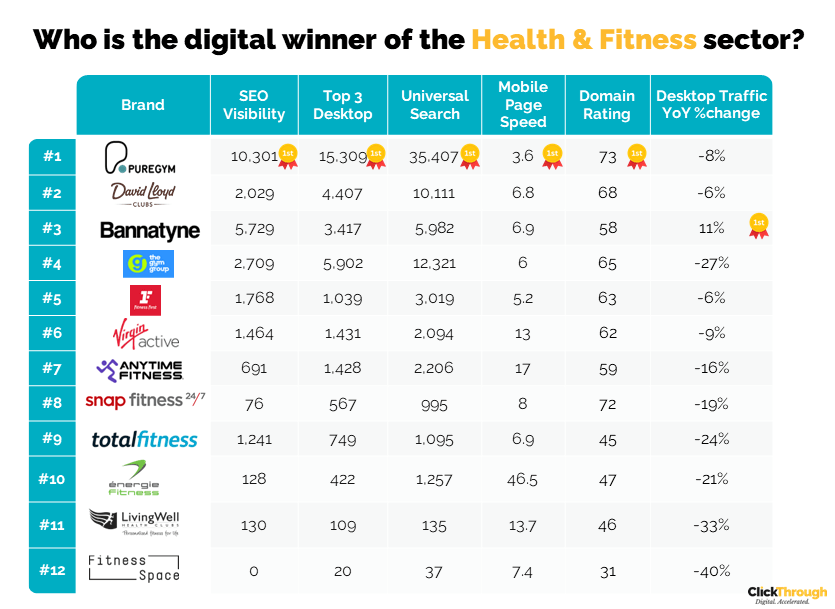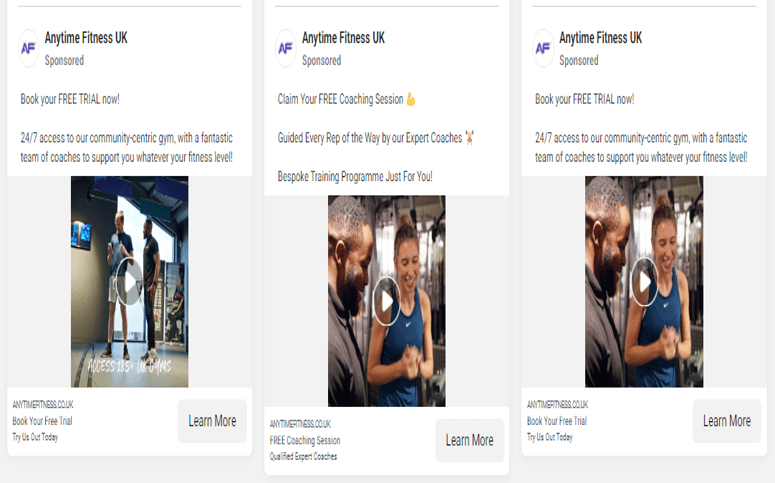The Q4 2023 benchmarking report for UK health and fitness clubs has just been published. Learn how the top 12 UK health and fitness clubs perform across the digital space.
The latest Q4 2023 benchmarking report for UK health and fitness clubs has just been published. It covers the 12 largest clubs in the UK, including David Lloyd Leisure, Virgin Active, The Gym Group, énergie Fitness, LivingWell Health Clubs, TotalFitness, Anytime Fitness, The Bannatyne Group, Fitness Space, Snap Fitness 24/7, PureGym, and Fitness First.

The research gives an inside track on who is winning the biggest share of voice online and quantifies the gaps, risks and missed opportunities for other health and fitness clubs to win brand exposure, drive online views, and increase membership figures. The report highlights quick wins that will improve enquiries from your online strategy and identifies the barriers that may be reducing your site’s ability to optimise digital performance.
To see a preview and contents page of the Q4 report, click here. To get a copy of the full report and the key takeaways, please complete the enquiry form or schedule a call. 
Q4 2023 WINNERS LEADERBOARD
For a glance into just six of the metrics we evaluated these top 12 health and fitness clubs on, check out our quick-look table below; 
Continue reading for further detail on this quarter's best and poorest-performing UK health and fitness clubs or request a copy of the report for the full review.
What The Industry Research Report Covers
The 70+ pages of research benchmarks each brand based on 50+ metrics and indicators of successful digital strategy, including organic visibility, domain authority, paid media ads, conversion performance, technical performance, site speed, universal search, content, social ads, accessibility, and mobile performance.
Driving Optimal ROAS from Paid Media Channels
Some of the leading players in the space are high spenders on paid media channels such as Google, Bing and Facebook - but have a poor or sub-optimal conversion improvement strategy. Without an optimised, sophisticated conversion strategy that maximises the conversion rate, the return on investment is unsustainable or will underperform. Scaling spend on paid media is not achievable unless the conversion rate delivers optimal performance in the sector. Some in the space have paid media spend levels from £30k+ per month but dedicate minimal resources and budgets to conversion testing. Given the cost per clicks on ad networks will continue to rise, we recommend spending at least 10% of your paid media budget on ongoing conversion optimisation testing schedules to ensure your paid media ROI maintains long-term viability, competitive advantage, and sustainability.
Technical Website Compliance
Savvy digital marketers know that having a technically sound website is an essential component of a successful fully integrated digital strategy - plus a site capable of maximising conversion performance. Health and fitness clubs have the benefit of not needing to maintain an ever-changing array of stock, so it should be relatively straightforward for these brands to avoid large volumes of 4xx errors.
In the last report, PureGym returned 449 4xx errors, which it’s reduced to 37 this quarter — an indication that it’s fixed pages with dead ends. In the last quarter, The Bannatyne Group had 1,926 5xx errors, and this health and fitness club has zero this quarter. This is great work by them!
Site Speed & Conversion Rate Performance
When 62% of consumers are less likely to convert if they have a negative mobile site experience, ensuring that your site is quick and easy to load will see a significant improvement on your overall conversion rates. Health and fitness clubs must ensure they are primed and ready for an increasingly mobile-first audience and are serving quick, easy to use mobile sites.
The higher end of mobile speed scores has increased for this quarter, with a range of 66 to 12, compared to 57 to 14 in the previous quarter. The Gym Group (66) and PureGym (65) have overtaken David Lloyd. Ten of the health and fitness clubs fall below the 50% benchmark. These clubs should look at their internal redirects to help increase their scores for the next quarter.
Building Competitive Advantage with Domain Authority
Domain authority (DA) is an essential metric for measuring the effectiveness of SEO performance and helps create a reliable overall gauge of how effective your site is at achieving organic traffic, i.e. ‘free’ traffic that isn’t gained through sponsored ads. Health and fitness clubs may want to collaborate with fitness publications and bloggers within the health niche, to expand their backlink profile and increase levels of relevant referral traffic.
The higher end of mobile speed scores has increased for this quarter, with a range of 66 to 12, compared to 57 to 14 in the previous quarter. The Gym Group (66) and PureGym (65) have overtaken David Lloyd. Ten of the health and fitness clubs fall below the 50% benchmark. These clubs should look at their internal redirects to help increase their scores for the next quarter.
Organic Performance – Mobile & Desktop
A strong organic performance is strategically important as it ensures your site ranks above competitors for core, transactional keywords. When 93% of your customers won’t go past the first page of Google, your absence or lack of targeting for essential keywords will cost you conversions. Due to the cost of living crisis, consumers may be cutting back on small luxuries such as gym memberships, and opting for at-home workout options or a membership at a cheaper club. Health and fitness clubs should be mindful that they are optimising and ranking for relevant terms, depending on current events and topics, in order to maintain traffic.
Similar to the previous report, all 12 health and fitness clubs have seen a decrease in their organic mobile traffic YoY. Fitness Space continues to see the biggest drop (95%) — an extra 35% traffic loss compared to the previous quarter. Fitness Space scores the second to lowest for Universal Searches for ‘people also ask’, which it should optimise to improve its organic mobile traffic.
Universal Search Opportunity
Google Universal Search Results are an evolving opportunity to make your pages visible on a SERP (Search Engine Results Page). Universal results often appear before traditional listings and are eye-catching for users. Universal search results refer to rankings on a SERP that are not the traditional ‘blue line’ Google link, and a site can appear for universal search results without being strong in standard rankings. Health and fitness clubs may find any of the Universal Search opportunities useful for sharing information and building brand awareness directly from the SERP. Results such as 'FAQs' and 'people also ask' questions will provide an opportunity to share knowledge of exercise and build authority, while 'local pack' will improve visibility in local areas.
PureGym continues to take the lead with the strongest performance for Universal Search results, with 35,407 total appearances. PureGym also has 15,500 searches for ‘people also ask’, implying it has a strong presence for longtail keywords. All 12 health and fitness clubs continue to use ‘local pack’ — a feature that’s prevalent for in-person services.
The Longtail Keyword Opportunity
Longtail keywords are often considered high intent and potentially more likely to convert as a searcher is being more specific. Optimising for longtail keywords also puts your content strategy in a strong position to rank for new search terms as they enter Google’s index. Health and fitness clubs can either look at developing content giving specific exercise advice, which will help funnel users from the brand awareness to consideration stage, or focus on building visibility around high-conversion-intent keywords, that may mention terms such as fees.
PureGym continues to secure the most rankings in the top 100 for longtail keywords, along with the most appearances in the top 3, 10, and 20 positions. Fitness Space has the lowest overall appearances, and this health and fitness club should incorporate a blog to expand its longtail keyword strategy
Facebook Adverts
With the number of Facebook users in the United Kingdom (UK) forecast to hit over 42 million users by 2022, it is not surprising that brands have jumped at the opportunity to advertise on the social media platform. Facebook’s UK digital advertising revenue has been estimated to have breached £2.6b in 2019. For UK health and fitness clubs, Facebook ads are an opportunity to reach more customers and share updates to their facilities.
Anytime Fitness’ three Facebook ads are centred around enticing customers to sign up for a free trial. The use of bucket brigades breaks up the content to make it more scannable as users scroll through their social media feed. This health and fitness club has used slight text variation across all three ads, suggesting it’ll late evaluate which verbiage performs best.

Top Social Shares & Content
When it comes to social media and on-site content strategies, it is important to release content that has a longer shelf life. An article is considered 'evergreen' if it has maintained its relevancy to an audience for a long period of time. It's great for your engagement, but great for Google too, who will recognise content that achieves traffic over a long period of time. Health and fitness clubs with a strong blog presence are likely to see more engagement from social media, with users keen to improve their technique or even copy some exercises at home.
All 12 health and fitness clubs continue to favour Facebook, and David Lloyd Leisure holds the number one spot for the highest number of engagements (15,475), though this is a huge drop from the previous quarter (78,701). PureGym has secured the most Facebook likes (509,000) and Instagram followers (207,000) — both of which have grown from the previous report.
Website Readability & Accessibility
About 20% of people in the UK have a disability – 2 million of which are people living with sight loss. In addition, 1 in 12 men and 1 in 200 women have some degree of colour vision deficiency. Health and fitness brands will want to carefully consider the impression they are giving users, from the first digital touchpoint. Prospective members who have a vision deficiency, or other additional needs, will need to know that they will be welcomed and supported in accessing facilities, beginning with the health and fitness club's website.
Fitness First flagged 77 alerts in the last quarter, and it’s increased this to 83 in Q4 2023. TotalFitness has the highest number of contrast errors again, with a total of 47. While this health and fitness club has a clear sense of branding across its homepage, its colour scheme for text can make it challenging for some people to read
GET THE FULL 70-PAGE Q4 2023 REPORT
To get a copy of the full report, please complete the enquiry form. If you want to talk to us about accelerating your digital performance, please call us on 01543 410014 or schedule a call with Mike Movassaghi.
Photo by Itzel González Lara on Unsplash





Let's be social
Join our growing social communities to learn more about the benefits of digital marketing and the people who make us tick.